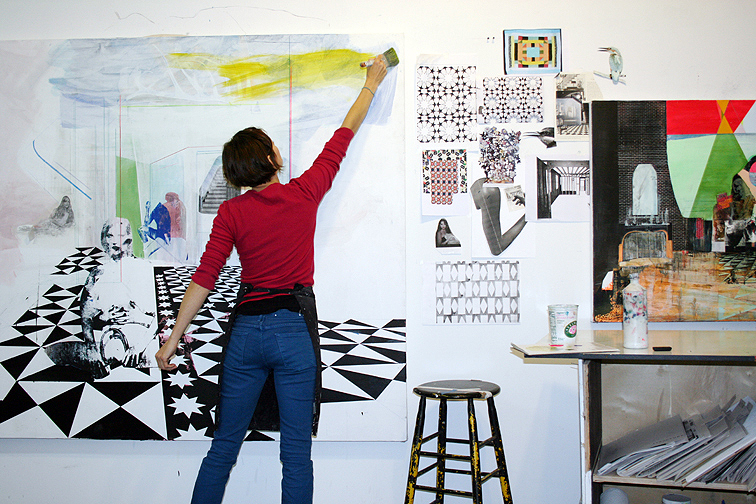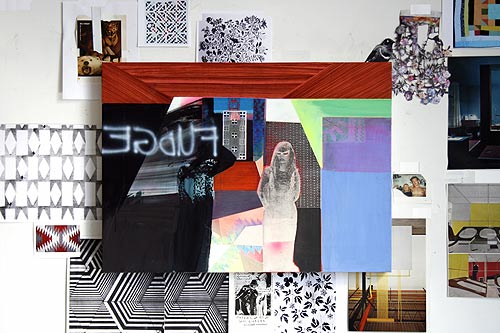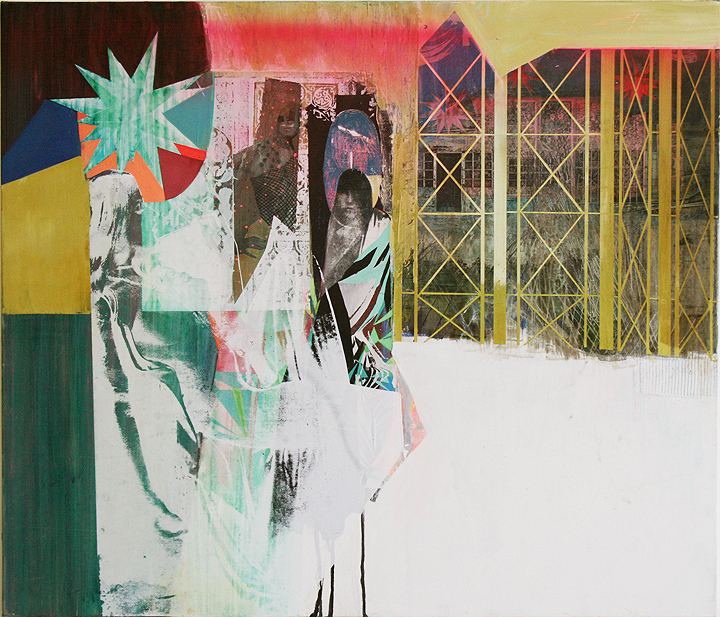Brooklyn artist Kristen Schiele opens her latest solo exhibition in New York on Wednesday the April 21st at the always great Sloan Fine Art. Entitled “Elektra”, the show promises a collection of paintings depicting 70’s inspired B-Movie actresses in stripped down architectural settings. This is Kristen’s second solo with the gallery since 2008 when she held the honour of the gallery’s inaugural solo exhibition with a body of work entitled “My Dream Is Yours“.
AM caught up with Kristen to find out a little more about her background, her connection to notable Austrian Expressionist painter Egon Schiele and the work she has made for the exhibition. Read on for our interview and some further studio and preview images after the jump.
Arrested Motion (AM): Hi Kristen. By way of an introduction, can you tell us a little about yourself, your background and your work?
Kristen Schiele (KS): My family moved around the US every few years as my father moved for the company Alcoa. We were also in Germany in the Frankfurt area. I think this double life of Germany and different states and cities keeps you seeing things new. There are fewer regular patterns in life, and you can see and be influenced by different worlds. Language, when you switch from one to another, can also be fascinating to see anew.
AM: I understand that you have a family connection to the late Expressionist painter Egon Schiele – can you share a little information about the relationship you have to him and how that may have influenced, inspired or affected you as a painter? Did your family actively encourage you to pursue a career in fine art?
KS: Egon Schiele has no direct relatives, no nieces or nephews or anything. His family tree sadly ended with the Spanish Influenza. Our family tie to him is in the Schiele line, and the influential mark he put on that name. What it gave me was an early exposure (probably too early) to his work through his books my grandparents collected, and a Schiele self portrait they bought before he was as popular an artist as today. The connection may be what started getting my grandmother and aunts interested in collecting art and what gave me the support I have gotten from my family. My father has been my patron and supported my work when it was less than great, shall we say?
AM: You’ve lived and studied in a wide range of places – Indiana, DC and Berlin included, but now call Brooklyn home. There seems to be a buoyant artistic community in Brooklyn – does it hold a particular interest to keep you there? How long have you lived there for?
KS: I’ve been in Brooklyn now for 9 years! NY is huge and the artist enclaves are scattered. My very unattractive but cheap neighborhood of Bushwick has turned into a major center for making art and music. Many of my favorite artists live just a few blocks away. I just left Natalie Frank’s studio, for example. That kind of influence makes life exciting. If I could have anything I would continue to spend summers in Berlin and the rest of the year in NY. LA is also tempting. Some of the work out there is insane.
AM: I’m interested to hear if you have seen your work change as your location has. Do you feel that location influences and inspires your work?
KS: When I do a residency or am in Berlin my studio changes. I don’t usually work on big paintings. I like the chance to bike around and spend time in libraries and bookshops, reading and collecting images. I do smaller works on paper and crazy weird stuff that keeps me energized in the studio.
AM: Did the approach to teaching you encountered in Germany differ greatly from your experiences in the USA?
KS: The approach varies but in Germany a professorship is known to be more prestigious than in the U.S. Hence the professors are huge stars (like Baselitz) and sometimes hardly show up! Hilarious! I interviewed for the Munich academy and the professor showed up late with two dogs and his woman friend who sat mute in the corner during the interview. Art school is boring but the students/ people you meet are inspirations for a lifetime. That is where to learn. Though I did find a monumental inspiration in professor John Walker. He has ESP. Brilliant.
AM: You studied stop motion animation in Germany, and also taught printmaking at the Corcoran School of Art in DC. How have these forms of mark-making been incorporated within and influenced your artistic output?
KS: I enjoy animation more than movies sometimes. Look at William Kentridge. What a voice. Animated images are magic, like prose in their way. Single-cell deep space is an early influence, but more than anything printmaking has influenced my work. I use lots of different kinds of processes to cut up the surface, jar the plane and shift the focus in the work. It helps me feel I’m putting time in the piece if not just offering parallel peripheral information. The silkscreen process helped get me to work with the figure. I wanted figures that echoed their original objectification. Also about 5 years ago, I was introduced to animators in LA who came from making commercial animations or from the commercial illustration world and now make crazy amazing paintings. I had never really looked at it in depth before. It is different from the kind of painting I was taught; the purist, dogmatic abstraction influenced Yale school based painting. I still think some of that work from LA is amazing – like with Tim Biskup or Eric White’s paintings – and through deep friendships, it has influenced the detail and more graphic nature of my work. I love that about art: it is a dialogue. We influence each other.
AM: Have you continued to produce animation work?
KS: I have planned collaborations, but I always seem to get lost in paintings or preparations for other works. I will covet the works of Martha Colburn who is awesome and works her ass off and Allison Schulnick until I grow more arms and more time to make animated movies.
AM: Your work has a great depth to it, due to the layering of paint and other media you use. I also enjoy your bold use of colour within the work. Where do you start when creating a piece of work – do you keep a sketch book? Can you talk us through a typical scenario in the creation of one of your canvases?
KS: I do keep a sketchbook. I also have a library of images printed out, some scanned in from libraries. They are from years of collecting. I get ideas and start folders of images for different paintings. I narrow the folders down into a show. I do a lot of reading – for this show, Julia Kristeva’s “Power of Horror” and Laura Mulvey’s “Mask and Curiosity” are killing me. Then I put the books down so I don’t get too literal. I start collages. I scan images and work on the collages then use those as reference for paintings, going nuts with processes and layers. The way I use oil paint takes a long time to dry. I have to wait a week or two to touch a piece so I work on up to 15 at a time. Then, I start getting rid of the ones that don’t work (a lot of them). I look for a balance in the work. They are abstract paintings, but I want to say something though them.
AM: Architectural landscapes often form the setting within your work; where does your interest in the use of architectural language come from?
KS: I’m not a nature girl. I am fascinated by structures, building and architecture and I feel a secret love of seeing the world from a structure, on a bike or in a car. I am the person in the pool next to the ocean but I love me that ocean no less.
AM: Female characters often feature within your paintings as the central character within the composition, defining a narrative for the setting and, I think, often creating a ‘noir’ theme within the work. Is this a conscious decision to use an all female cast? How does the decision to combine people within the places you depict develop?
KS: When I watch a movie, especially the stylized 70s movies like “Daughters of Darkness” or “Susperia” by Dario Argento, or watch a Fassbinder movie, I’m struck by how much more liberated the women are, how utterly feminist these erotic punk-ass movies are. The women are half naked but they are vampires so you DIE!!! Or they are in the closet as the murderer and you DIE!!!! That is power. They are also frank in their nudity and often doing really fake lesbian scenes. Fake lesbians crack me up! The psychology in these movies is fun to play with, and I like to cast my own little movies on the canvas.
AM: Your installations fascinate me, as the content, colours and textures you use within seem almost like they could be a model set for one of your paintings, rather than just reflecting your painting style. You were commissioned to create an installation at the Scope Art Fair in NY in 2009 – What is it that you hope to achieve and capture within a site specific installation?
KS: That installation was an amazing experience. I worked with a big crew of smart and talented people. We built a huge cabin from Brooklyn found objects and donated junk and built it in Lincoln Center. There were a lot of lights and electronics that you could only see if you were in the piece. And it is now in the garbage!! But it was amazing to work in a crew. It was like a family. Painting is solitary. I see no one for months. I’ve had to learn to balance this solitude with the life we breathe and live, and installation was a way of immersing myself in ideas shared with other people. It was so much physical labor my arms almost fell off however.
AM: Does planning and building an installation give you a different level of satisfaction from working on a canvas? Installations are often transitory, whereas a canvas can have permanence on someone’s wall. I’d be interested to hear your thoughts also on taking an installation down.
KS: Installations are giving. They are an easy way to engage people. They are a party. Paintings stare at you. They can be stuck up. I love the immediacy of installations, the concrete feel of them, and I brought that feeling of construction to the new paintings. It works back and forth, one practice informs the other. But my main work is in paintings. I find it the most challenging and fun.
AM: Your next solo show opens later this month at Sloan Fine Art, and is entitled ‘Elektra’. I believe that the original title was to be ‘New Model Army’. Can you discuss what signaled the change in title for you, and what this new body of work means to you?
KS: The paintings turned into movie portraits rather than scenes or narratives. The original idea was to create a legion of cheesy bad-ass women to be a new model for an army. The title was a play on the band name New Model Army. But in the end, I decided armies were a boy’s game and a bad one at that, so I gave them their sleazy title deriving from the Electra Complex, a term for the inverse of the Oedipus Complex. I gave it a German K for the ELEKTRA.
AM: I think that Alix Sloan is an excellent gallerist and curator and I believe that your work is well suited to her gallery. I guess it’s most important to an artist to have home representation, but you are represented by other notable gallerists internationally. I’d be interested if you think your work for this solo show would be different if it were to be held in say, Denver, Los Angeles or Berlin?
KS: Alix is great. She loves art and is a sincere and passionate person. I made work to fit with her gallery and space as I do with an installation. It is a challenge for me to work small. Give me 6 feet please. But this allowed me to do portraits and smaller worlds, and Alix helps me visually and with practical matters. Each gallery is different.
AM: With regards to your output and the creation of your work, do you tend to consciously focus on a ‘body’ of work at any point in time, or might you be working on a series of different pieces that seem to come together for an exhibition?
KS: My concepts are important for me. I make bodies of work. Some don’t fit and are ideas on their own, but the groups are important to me. It’s like writing a novel instead of a sentence.
AM: Finally, after ‘Elektra’ what other plans do 2010 hold for you?
KS: I think I may have a beer. And make big ass scenic paintings. And hope I get to show in Berlin sometime soon. My gallery there closed last year. But here is to making work wherever we are!
AM: Many thanks for sharing some time with us Kristen. We wish you every success with the new show – have fun and enjoy that beer. Cheers!
Kristen Schiele
“Elektra”
Opening Reception: Wednesday, April 21st, 6 to 8 pm
Exhibition: April 21 to May 15, 2010
Sloan Fine Art
128 Rivington Street
New York, NY 10002
Discuss Kristen Schiele here.









